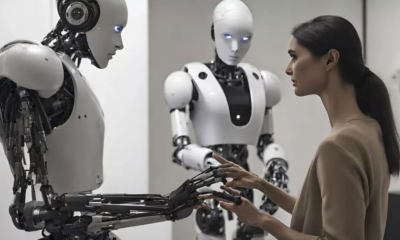Tools & Platforms
4 ways retailers are adopting AI, robotics, and other new tech in 2025

4 ways retailers are adopting AI, robotics, and other new tech in 2025
There have been seismic shifts in how people shop. Customers seek even more convenience, faster transactions, and a personalized shopping experience.
However, data shows that retailers are struggling to meet these consumer needs. According to a 2024 IBM study, only 9% of consumers reported being satisfied with their in-store shopping experiences, while just 14% expressed satisfaction with online shopping.
This is where artificial intelligence has begun to fill the gap. Retailers are rapidly turning to AI-driven technologies to enhance the shopping experience and address these key pain points. In fact, 59% of consumers have shown interest in using AI applications while shopping, while 80% admitted they haven’t yet tried AI-powered shopping tools but are eager to explore them, according to the IBM survey.
As a result, companies are heavily investing in artificial intelligence, robotics, and interactive technologies to bridge these gaps. With AI-powered self-checkout systems that reduce wait times, QR Codes that provide instant product information, and virtual assistants that streamline customer service, retailers are reshaping how people shop, buy, and sell.
With AI adoption within the retail landscape accelerating, Uniqode analyzed industry reports and news articles to explore the latest advancements in shopping technology and what consumers may start encountering as they shop in the future
Delivery robots
Autonomous delivery robots are gaining momentum in major cities like Chicago and Los Angeles as restaurants and retailers look to improve efficiency, cut costs, and meet rising demand for faster, more reliable deliveries.. These robots use advanced navigation systems, cameras, and sensors to safely transport orders from businesses to customers, reducing reliance on human couriers.
In Los Angeles, fast-casual burger chain Shake Shack partnered with Serve Robotics and Uber Eats to offer robot deliveries at select locations. These robots navigate sidewalks using advanced mapping technology to deliver food directly to customers without human involvement.
Globally, in places such as Chicago, Miami, Los Angeles, and Helsinki, Coco delivery robots are helping businesses fulfill local orders using small, wheeled robots that travel on sidewalks. Unlike traditional bike or car deliveries, these robots bypass traffic, lower delivery costs, and improve order fulfillment efficiency. Coco uses QR Codes displayed on the outside of each robot to help businesses accurately fulfill orders.
Coco robots are used in collaboration with companies such as DoorDash, Uber Eats, and OpenAI.
Beyond food delivery, Vayu Robotics has developed an on-road, AI-powered delivery robot designed to operate without expensive lidar sensors, a technology that uses pulses of laser light typically used in drones for aerial and 3D mapping.
Instead, it uses a more affordable vision-based system to transport goods, making last-mile logistics more scalable and accessible for retailers and e-commerce brands.
Drone deliveries
Drones are helping to reduce delivery issues in urban and rural areas, such as traffic congestion, long wait times, and infrastructure limitations. Equipped with advanced navigation systems and AI-powered flight controls, drones can transport goods quickly and efficiently. PwC projected drones will complete about 14,000 deliveries per day, adding up to nearly five million B2C deliveries globally in 2024.
One of the leading players in this space, Zipline, has already completed over 1.4 million deliveries and is rapidly expanding its operations across Africa and the United States. Zipline’s drones use precision airdrop technology to deliver medical supplies, groceries, and retail goods to hard-to-reach locations. This is particularly valuable for health care providers and logistics companies looking to serve remote or underserved communities.
Big-box retailers such as Walmart are expanding their drone delivery networks to offer faster and, in some cases, same-day delivery. Dallas has become a key testing ground city for Walmart’s aerial delivery program, where the retailer has partnered with Wing, Alphabet’s drone delivery subsidiary, to offer same-day deliveries for select products. The drones can deliver small orders, such as groceries, household essentials, and pharmacy items, in as little as 30 minutes, reducing wait times for customers. QR Codes on the ground assist in landing the Wing drones back at home base.
AI-driven shopping
Artificial intelligence is redefining how consumers shop by enabling frictionless checkout, personalized shopping experiences, and smarter inventory management.
Amazon’s Just Walk Out technology uses AI-powered sensors and machine learning to allow shoppers to grab and go without checking out at a register. Purchases are automatically charged to shoppers’ accounts. The technology has been used at Amazon Fresh and Amazon Go stores across the United States, with plans for broader adoption in high-traffic convenience stores and concession areas.
Blockchain platform Pundi X launched PundiPay for merchants. In this system, retailers can generate and display a QR Code that allows customers to pay with crypto on their devices.
With more consumers interested in using AI technology in their retail experience for convenience, many retailers have begun integrating AI-driven technologies to boost customer satisfaction. This includes AI-powered product recommendations, automated restocking, and smarter inventory management.
Spatial computing
Spatial computing merges digital and physical retail spaces to create interactive shopping environments. AI technology leverages augmented reality to provide shoppers with advanced features such as virtual try-ons, AI-powered store navigation, and personalized digital displays that respond to real-time customer behavior.
Millions of Olympics enthusiasts got to experience one such concept at the 2024 Paris Olympics with retail giant Alibaba’s Wonder Avenue pop-up, a 289-foot-long showcase of shopping technology that blends physical and digital experiences. Shoppers went through different areas in the showcase where they could create personal avatars, digitally “try on” products via their avatars to imagine their perfect looks, and even pick out cosmetics and fragrances based on tailored recommendations from a smart assistant.
Other spatial computing applications include AI-powered navigation systems that help customers find store products quickly by providing real-time directions within large retail spaces, such as malls. Interactive digital displays facilitated by QR Codes on products or in catalogs can also help customers design a product they will eventually purchase, such as how Ikea used AR apps to help buyers imagine what furniture and decor will look like in their homes.
These AI-driven technologies are reshaping how customers interact with physical retail environments, blending digital convenience with in-store experiences.
As retailers continue to invest in AI, robotics, and immersive technologies, the lines between physical and digital shopping will only blur further. From sidewalk robots to aerial drones, personalized AI tools to spatial computing experiences, the retail journey is becoming faster, smarter, and more engaging.
In 2025 and beyond, staying ahead means not just keeping up with innovation but reimagining how technology can meet rising consumer expectations at every touchpoint.
Additional research by Emma Rubin and Alizah Salario. Story editing by Carren Jao. Additional editing by Elisa Huang. Copy editing by Kristen Wegrzyn. Photo selection by Lacy Kerrick.
This story was produced by Uniqode and was produced and distributed in partnership with Stacker.
Tools & Platforms
Can AI teach us how animals think?

Now we have a better idea, thanks to a Milan-based researcher who has developed an AI model that he claims can detect whether their calls express positive or negative emotions.
Stavros Ntalampiras’s deep-learning model, which was published in Scientific Reports, can recognise emotional tones across seven species of hoofed animals, including pigs, goats and cows. The model picks up on shared features of their calls, such as pitch, frequency range and tonal quality.
The analysis showed that negative calls tended to be more mid to high frequency, while positive calls were spread more evenly across the spectrum. In pigs, high-pitched calls were especially informative, whereas in sheep and horses the mid-range carried more weight, a sign that animals share some common markers of emotion but also express them in ways that vary by species.
For scientists who have long tried to untangle animal signals, this discovery of emotional traits across species is the latest leap forward in a field that is being transformed by AI.
The implications are far-reaching. Farmers could receive earlier warnings of livestock stress, conservationists might monitor the emotional health of wild populations remotely, and zookeepers could respond more quickly to subtle welfare changes.
This potential for a new layer of insight into the animal world also raises ethical questions. If an algorithm can reliably detect when an animal is in distress, what responsibility do humans have to act? And how do we guard against over-generalisation, where we assume that all signs of arousal mean the same thing in every species?
Of barks and buzzes
Tools like the one devised by Ntalampiras are not being trained to “translate” animals in a human sense, but to detect behavioural and acoustic patterns too subtle for us to perceive unaided.
Similar work is underway with whales, where New York-based research organisation Project Ceti (the Cetacean Translation Initiative) is analysing patterned click sequences called codas.
Long believed to encode social meaning, these are now being mapped at scale using machine learning, revealing patterns that may correspond to each whale’s identity, affiliation or emotional state.
In dogs, researchers are linking facial expressions, vocalisations and tail-wagging patterns with emotional states. One study showed that subtle shifts in canine facial muscles correspond to fear or excitement. Another found that tail-wag direction varies depending on whether a dog encounters a familiar friend or a potential threat.
At Dublin City University’s Insight Centre for Data Analytics, we are developing a detection collar worn by assistance dogs which are trained to recognise the onset of a seizure in people who suffer from epilepsy. The collar uses sensors to pick up on a dog’s trained behaviours, such as spinning, which raise the alarm that their owner is about to have a seizure.
The project, funded by Research Ireland, strives to demonstrate how AI can leverage animal communication to improve safety, support timely intervention, and enhance quality of life. In future we aim to train the model to recognise instinctive dog behaviours such as pawing, nudging or barking.
Honeybees, too, are under AI’s lens. Their intricate waggle dances – figure-of-eight movements that indicate food sources – are being decoded in real time with computer vision. These models highlight how small positional shifts influence how well other bees interpret the message.
Caveats
These systems promise real gains in animal welfare and safety. A collar that senses the first signs of stress in a working dog could spare it from exhaustion. A dairy herd monitored by vision-based AI might get treatment for illness hours or days sooner than a farmer would notice.
Detecting a cry of distress is not the same as understanding what it means, however. AI can show that two whale codas often occur together, or that a pig’s squeal shares features with a goat’s bleat. The Milan study goes further by classifying such calls as broadly positive or negative, but even this remains using pattern recognition to try to decode emotions.
Emotional classifiers risk flattening rich behaviours into crude binaries of happy/sad or calm/stressed, such as logging a dog’s tail wag as “consent” when it can sometimes signal stress. As Ntalampiras notes in his study, pattern recognition is not the same as understanding.
One solution is for researchers to develop models that integrate vocal data with visual cues, such as posture or facial expression, and even physiological signals such as heart rate, to build more reliable indicators of how animals are feeling.
AI models are also going to be most reliable when interpreted in context, alongside the knowledge of someone experienced with the species.
It’s also worth bearing in mind that the ecological price of listening is high. Using AI adds carbon costs that, in fragile ecosystems, undercut the very conservation goals they claim to serve. It’s therefore important that any technologies genuinely serve animal welfare, rather than simply satisfying human curiosity.
Whether we welcome it or not, AI is here. Machines are now decoding signals that evolution honed long before us, and will continue to get better at it.
The real test, though, is not how well we listen, but what we’re prepared to do with what we hear. If we burn energy decoding animal signals but only use the information to exploit them, or manage them more tightly, it’s not science that falls short – it’s us.
Tools & Platforms
Is It a High-Conviction Buy Amid AI Infrastructure Growth and Energy Constraints?

The AI infrastructure boom has created a seismic shift in the tech landscape, with data centers demanding unprecedented speed, scalability, and energy efficiency. Credo Technology (CRDO) has emerged as a pivotal player in this transformation, leveraging its high-speed connectivity solutions to address the dual challenges of performance and power consumption. However, as the sector grapples with energy bottlenecks and intensifying competition, investors must weigh CRDO’s strategic advantages against its macro risks.
Financial Strength and Strategic Innovation
Credo’s fiscal 2025 results underscore its rapid ascent: revenue surged to $436.77 million, a 126.34% year-over-year increase, while net income jumped 283.94% to $52.18 million [3]. This growth is fueled by demand for its Active Electrical Cables (AECs) and optical digital signal processors (DSPs), which offer 50% lower power consumption and 100x greater reliability than traditional optical solutions [1]. The company’s gross margin of 64.77% and a cash balance of $236.33 million further highlight its financial discipline [3].
Credo’s system-level strategy—integrating SerDes IP, Retimer ICs, and the PILOT software platform—enables faster time-to-market and system-level optimization for hyperscalers [1]. Innovations like the 112G PAM4 SerDes IP and 3nm 200G-per-lane optical DSPs position it to capitalize on the industry’s shift to 200G lane speeds [3]. Analysts project revenue exceeding $800 million in 2026, with a non-GAAP net margin approaching 40% [1].
Competitive Edge in a High-Stakes Market
The AI infrastructure market is projected to grow at a 17.71% CAGR through 2030, driven by energy-efficient cooling, AI-specific networking, and government subsidies [4]. Credo’s focus on low-power, high-bandwidth interconnects aligns with this trajectory. Its AECs, which dominate hyperscaler demand, have driven double-digit sequential growth, while its 3nm optical DSP supports port speeds up to 1.6 Tbps [1].
However, competitors like Broadcom and Marvell are also advancing optical connectivity and custom silicon solutions [2]. Credo’s pure-play focus on high-speed connectivity and proprietary technologies, such as the PILOT platform, provides differentiation. Its 33.4% R&D investment ratio reinforces innovation cycles, a critical edge in a capital-intensive industry [3].
Navigating Energy Constraints and Macro Risks
AI data centers face existential energy challenges. Grid capacity constraints, with 72% of respondents in a Deloitte 2025 survey citing it as a “very challenging” issue, threaten to delay 20% of planned projects [1]. Credo’s energy-efficient solutions mitigate this risk, but the broader industry’s reliance on fossil fuels to meet AI’s power demands raises sustainability concerns [6].
Customer concentration remains a vulnerability: Microsoft accounted for 86% of Q3 2025 revenue [5]. While Credo is diversifying into new hyperscaler relationships and the PCIe retimers market, overreliance on a few clients could destabilize growth. Additionally, its forward 12-month Price/Sales ratio of 26.02, well above the sector average of 8.83, suggests valuation risks [5].
Analyst Outlook and Strategic Resilience
Despite these risks, analysts remain bullish. Mizuho raised its price target to $135, citing Credo’s leadership in AI infrastructure, while Stifel set a $115 target [2]. TD Cowen labeled CRDO its “Best Smidcap Idea for 2025,” emphasizing its role in hyperscaler AI adoption [5]. Post-patent settlement, Credo’s legal risks have diminished, opening avenues for licensing revenue [5].
Conclusion: A High-Conviction Buy?
Credo’s strategic positioning in the AI infrastructure boom is compelling. Its energy-efficient solutions, robust financials, and system-level innovation address critical industry pain points. Yet, energy bottlenecks, competitive pressures, and valuation concerns demand caution. For investors with a long-term horizon and a tolerance for volatility, CRDO’s projected 85%+ revenue growth and strong balance sheet justify a high-conviction buy, provided diversification and sustainability risks are monitored.
Source:
[1] Credo Technology and the AI Infrastructure Boom [https://www.ainvest.com/news/credo-technology-ai-infrastructure-boom-strategic-play-data-center-revolution-2508/]
[2] How Does Credo’s System-Level Strategy Provide an Edge in the AI Era [https://www.nasdaq.com/articles/how-does-credos-system-level-strategy-provide-edge-ai-era]
[3] Credo Technology Group Holding Ltd (CRDO) Financial & [https://www.monexa.ai/blog/credo-technology-group-holding-ltd-crdo-financial–CRDO-2025-08-06]
[4] AI Infrastructure Market Statistics: Size, Growth, & Trends [https://thenetworkinstallers.com/blog/ai-infrastructure-market-statistics/]
[5] Credo Technology (CRDO): AI Growth, Risks, and Market Outlook [https://www.monexa.ai/blog/credo-technology-crdo-ai-growth-risks-and-market-o-CRDO-2025-03-06]
[6] The growing environmental impact of AI data centers’ energy demands [https://www.pbs.org/newshour/show/the-growing-environmental-impact-of-ai-data-centers-energy-demands]
Tools & Platforms
xAI sues former engineer for allegedly stealing ChatGPT-beating technology

Elon Musk’s artificial intelligence company xAI filed a federal lawsuit on August 28, 2025, against former engineer Xuechen Li, alleging theft of confidential information containing “cutting-edge AI technologies with features superior to those offered by ChatGPT.” The 29-page complaint filed in the Northern District of California seeks damages and emergency injunctive relief to prevent Li from working at OpenAI while the case proceeds through court.
Li, who joined xAI in February 2024 as one of approximately 20 initial engineers, had “access to and responsibility for components across the entirety of xAI’s technology stack,” according to court documents. The complaint alleges Li uploaded proprietary data to personal storage systems on July 25, 2025, three days before resigning to accept a position at OpenAI with an August 19 start date.
Subscribe PPC Land newsletter ✉️ for similar stories like this one. Receive the news every day in your inbox. Free of ads. 10 USD per year.
The timing proves particularly damaging for xAI’s case. Li sold approximately $7 million in company stock through two transactions facilitated by xAI itself – receiving $4.7 million on July 23 and $2.2 million on July 25, the same day he allegedly copied confidential files. Court filings reveal that xAI facilitated the second transaction “because xAI valued his contributions, and wanted to retain him as a productive and successful employee.”
Li’s alleged misconduct emerged during routine security reviews after he departed the company. According to the complaint, Li “admitted in a handwritten document he provided to xAI that he misappropriated xAI’s Confidential Information and trade secrets.” The admission occurred during meetings at Winston & Strawn’s offices in Redwood City on August 14 and 15, 2025, with his criminal defense attorney present.
The legal documents detail Li’s efforts to conceal his activities. He “deleted his browser history and system logs, renamed files, and compressed files prior to uploading them to his Personal System,” according to the complaint. Li also changed critical account passwords on August 11, 2025, after receiving xAI’s demand letter, then claimed he could not “remember” the new credentials during subsequent negotiations.
The lawsuit emerges amid intense competition for AI talent between major technology companies. Recent litigation trends highlight escalating disputes over intellectual property and market control in the artificial intelligence sector. The case follows multiple high-profile legal battles involving AI companies and content creators over training data usage and copyright protection.
xAI’s complaint emphasizes the extraordinary financial investment required for AI development. The company states that “advanced AI models can cost greater than hundreds of millions of dollars to develop,” with xAI investing billions in its intellectual property development. The lawsuit notes that “maintaining the utmost secrecy in the development of AI models is of critical importance” given the competitive landscape.
The stolen information allegedly relates to Grok, xAI’s conversational AI system launched in November 2023. Court documents describe Grok 4 as “one of the most, if not the most, advanced and powerful generative AI systems in the world, leading industry benchmarks in reasoning and pretraining capabilities.” The technology enables natural language processing, image generation, and audio response capabilities.
Market dynamics underscore the lawsuit’s significance for the AI industry. According to xAI’s filings, “experts predict that the market value of AI technology will exceed hundreds of billions of dollars this year, and over a trillion dollars by decade’s end.” The complaint notes that OpenAI currently controls “over 80 percent of the generative AI chatbot market” after ChatGPT’s November 2022 launch sparked widespread adoption.
Li signed comprehensive confidentiality agreements upon joining xAI, including an Employee Confidential Information and Invention Assignment Agreement defining protected information. The agreement covers “trade secrets, proprietary technology, inventions, mask works, ideas, processes, formulas, software in source or object code, data, programs” and other technical materials.
Additionally, Li executed a Termination Certificate on August 1, 2025, falsely representing compliance with confidentiality obligations. The document required him to certify returning all company materials and deleting any confidential information from personal systems. Court filings reveal these representations were “knowingly false” as Li retained xAI’s proprietary data.
The case highlights broader tensions within the AI industry over employee mobility and trade secret protection. xAI’s complaint argues the stolen secrets “could save OpenAI and other competitors billions in R&D dollars and years of engineering effort, handing any competitor a potential overwhelming edge in the race to dominate the AI landscape.”
xAI implemented extensive security measures to protect its intellectual property, including SOC 2 Type II compliance, NIST 800-171 Rev.3 framework adoption, security awareness training, background checks, and endpoint encryption. The company maintains dedicated information security teams and conducts regular assessments to protect confidential materials.
Buy ads on PPC Land. PPC Land has standard and native ad formats via major DSPs and ad platforms like Google Ads. Via an auction CPM, you can reach industry professionals.
The lawsuit seeks temporary restraining orders requiring Li to surrender personal devices for forensic examination and preventing his employment at OpenAI until all confidential information is deleted. xAI also requests permanent injunctions against disclosure or use of its trade secrets, plus monetary damages, attorneys’ fees, and punitive damages.
Legal experts note the case’s potential impact on AI industry employment practices. The lawsuit challenges common talent mobility patterns while testing courts’ willingness to restrict employee movement between competing AI companies. The outcome could establish precedents for protecting proprietary AI technologies through contractual and legal mechanisms.
Li’s case follows recent AI-related litigation trends, including privacy disputes over meeting recording technologies and regulatory challenges to content moderation requirements. Courts increasingly confront complex questions about AI development, intellectual property protection, and competitive practices within rapidly evolving technology markets.
The Northern District of California court will determine whether xAI’s emergency relief requests merit temporary restrictions on Li’s employment while the underlying trade secret claims proceed to trial. The case represents one of the most significant AI trade secret disputes to emerge from Silicon Valley’s competitive talent marketplace.
Subscribe PPC Land newsletter ✉️ for similar stories like this one. Receive the news every day in your inbox. Free of ads. 10 USD per year.
Timeline
- February 26, 2024: Xuechen Li begins employment at xAI as Member of Technical Team, signing confidentiality agreement
- June 2025: Li sells $4.7 million in xAI stock through company-facilitated transaction
- July 23, 2025: Li receives cash proceeds from first stock sale ($4.7 million)
- July 25, 2025: Li receives additional $2.2 million from second stock sale and allegedly uploads confidential xAI data to personal systems
- July 28, 2025: Li suddenly resigns from xAI, having already accepted position at OpenAI
- August 1, 2025: Li signs false Termination Certificate claiming compliance with confidentiality obligations
- August 11, 2025: xAI discovers Li’s data theft during routine security review and sends demand letter; Li changes critical account passwords
- August 14-15, 2025: Li admits to theft in meetings with criminal defense attorney present at Winston & Strawn offices
- August 18, 2025: Li signs Authorization agreement but provides incomplete account access information
- August 19, 2025: Li’s scheduled start date at OpenAI
- August 28, 2025: xAI files federal lawsuit in Northern District of California
- August 29, 2025: Musk’s xAI files additional antitrust lawsuit against OpenAI and Apple
Subscribe PPC Land newsletter ✉️ for similar stories like this one. Receive the news every day in your inbox. Free of ads. 10 USD per year.
Summary
Who: xAI Corp. and X.AI LLC filed lawsuit against former engineer Xuechen Li, a Chinese national and Stanford PhD who worked as one of xAI’s first 20 engineers.
What: Federal lawsuit alleging trade secret theft, breach of contract, fraud, and computer access violations. xAI claims Li stole “cutting-edge AI technologies with features superior to those offered by ChatGPT” and seeks injunctive relief to prevent his employment at OpenAI.
When: Lawsuit filed August 28, 2025, following alleged data theft on July 25, 2025, and Li’s resignation on July 28, 2025. Critical events occurred between Li’s stock sales in June-July 2025 and his planned August 19 start date at OpenAI.
Where: Case filed in US District Court for Northern District of California (Case No. 3:25-cv-07292). Li worked at xAI’s Palo Alto headquarters and resides in Mountain View, California.
Why: xAI argues Li’s theft threatens its competitive position in the AI market worth hundreds of billions annually. The stolen technology could save competitors “billions in R&D dollars and years of engineering effort,” potentially undermining xAI’s market expansion strategy and product development roadmap.
PPC Land explains
xAI: Elon Musk’s artificial intelligence company founded in 2023, developing the Grok conversational AI system. The Nevada-based corporation operates from Palo Alto, California, and positions itself as a competitor to OpenAI’s ChatGPT with claims of superior reasoning capabilities. According to court documents, xAI has invested billions in developing its proprietary AI technology and achieved significant market recognition within two years of operation.
Trade Secrets: Confidential business information that derives economic value from not being generally known to competitors. In AI development, trade secrets encompass model weights, training methodologies, system prompts, algorithmic improvements, and technical know-how. The lawsuit emphasizes that trade secrets protect “nearly all of xAI’s developments” including cutting-edge technologies with features allegedly superior to competing products like ChatGPT.
OpenAI: The artificial intelligence research company behind ChatGPT, currently controlling over 80 percent of the generative AI chatbot market according to court filings. Founded as a research organization, OpenAI has evolved into a commercial entity offering AI services through its GPT models. The company represents Li’s new employer and xAI’s primary competitor in the conversational AI marketplace.
Confidential Information: Legally protected proprietary data covered under employment agreements, including technical specifications, business strategies, financial data, and developmental processes. Court documents define this broadly as “any and all confidential knowledge, data or information” that competitors could use for competitive advantage. Li’s confidentiality agreement specifically covered inventions, software code, and non-public information relating to xAI’s operations.
Grok: xAI’s flagship conversational AI system launched in November 2023, described in court documents as “one of the most advanced and powerful generative AI systems in the world.” The technology performs natural language processing, image generation, and audio response functions. The latest version, Grok 4, allegedly leads industry benchmarks in reasoning and pretraining capabilities, representing billions in development investment.
Misappropriation: The unauthorized acquisition, disclosure, or use of trade secrets by someone with access to confidential information. Federal law defines this as obtaining trade secrets through improper means including theft, misrepresentation, and breach of confidentiality duties. The lawsuit alleges Li misappropriated xAI’s proprietary technology by copying files to personal systems without authorization, then concealing his actions through technical cover-up methods.
Artificial Intelligence: Computer systems designed to perform tasks typically requiring human intelligence, including learning, reasoning, and problem-solving. The lawsuit emphasizes AI’s transformative impact, noting that generative AI adoption occurred faster than personal computers or internet adoption. Market projections estimate AI technology value exceeding hundreds of billions in 2025, reaching over one trillion dollars by decade’s end.
ChatGPT: OpenAI’s conversational AI chatbot launched in November 2022, powered by generative pre-trained transformer models including GPT-3.5, GPT-4, and GPT-o3. The service marked widespread public access to conversational AI tools and achieved rapid market dominance. Court documents position ChatGPT as the primary competitive benchmark against which xAI measures Grok’s superior features and capabilities.
Federal Lawsuit: Legal action filed in United States District Court alleging violations of federal statutes including the Defend Trade Secrets Act, Computer Data Access Fraud Act, and breach of contract claims. The Northern District of California case seeks monetary damages, injunctive relief, and emergency orders preventing Li’s employment at OpenAI. Federal jurisdiction applies because the case involves interstate commerce and federally protected intellectual property rights.
Injunctive Relief: Court orders requiring parties to perform or refrain from specific actions, typically granted when monetary damages prove inadequate to address ongoing harm. xAI seeks temporary restraining orders preventing Li from working at OpenAI, accessing personal devices containing stolen data, and disclosing confidential information. The company argues that immediate court intervention is necessary to prevent irreparable competitive damage and protect proprietary technology investments.
-
Tools & Platforms3 weeks ago
Building Trust in Military AI Starts with Opening the Black Box – War on the Rocks
-

 Ethics & Policy1 month ago
Ethics & Policy1 month agoSDAIA Supports Saudi Arabia’s Leadership in Shaping Global AI Ethics, Policy, and Research – وكالة الأنباء السعودية
-

 Events & Conferences3 months ago
Events & Conferences3 months agoJourney to 1000 models: Scaling Instagram’s recommendation system
-

 Business2 days ago
Business2 days agoThe Guardian view on Trump and the Fed: independence is no substitute for accountability | Editorial
-

 Jobs & Careers2 months ago
Jobs & Careers2 months agoMumbai-based Perplexity Alternative Has 60k+ Users Without Funding
-

 Funding & Business2 months ago
Funding & Business2 months agoKayak and Expedia race to build AI travel agents that turn social posts into itineraries
-

 Education2 months ago
Education2 months agoVEX Robotics launches AI-powered classroom robotics system
-

 Podcasts & Talks2 months ago
Podcasts & Talks2 months agoHappy 4th of July! 🎆 Made with Veo 3 in Gemini
-

 Podcasts & Talks2 months ago
Podcasts & Talks2 months agoOpenAI 🤝 @teamganassi
-

 Mergers & Acquisitions2 months ago
Mergers & Acquisitions2 months agoDonald Trump suggests US government review subsidies to Elon Musk’s companies



















